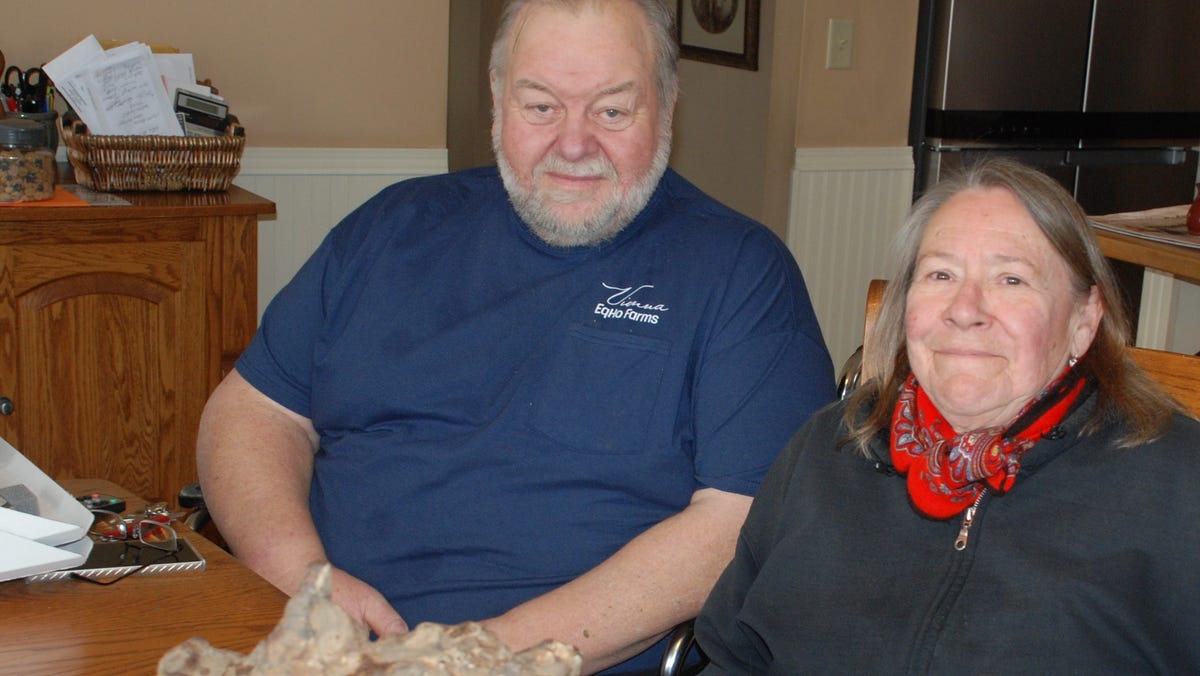One of the rituals of spring on the farm is rock picking. Not by any means a glamorous job or one that might bring anything resembling a surprise.
But for us it did.
A few years ago we found a “rock” that didn’t look anything like the thousands of small and large stones found on our farm over many generations.
We knew it was something different and now we have scientific proof.
It is a meteorite.
Dane County meteorite is estimated to be 4.55 billion years old, and the state’s largest
Experts at the University of Wisconsin-Madison have verified it as a meteorite made of iron and nickel, created in the solar system’s earliest days. It likely started out as part of an asteroid or protoplanet, says Richard Slaughter, director of University of Wisconsin-Madison’s Geology Museum.
He and his colleagues at the Department of Geoscience put the age of the 109.5 pound meteorite at 4.55 billion years old.
“Dating all of these iron meteorites consistently gives us that age,” Slaughter said. “New ones could be dated but they really don’t need to be. They are all about the same age.”
The meteorite likely ended up on our Dane County farm after traveling from the region of the solar system between Mars and Jupiter.
When we first found the “rock” we were pretty sure we had something out of the ordinary, but getting advice or input from scientists turned out to be more difficult than we had thought.
We shared our discovery with our brother-in-law Joe Zanter, a metallurgical engineer. He sought input from scientists at the Field Museum of Natural History in Chicago. My sister Laurie Shepel searched for advice from geoscience experts around the country to help identify the object. While we were excited about the discovery, it was difficult to find anyone else, except Joe and Laurie, who shared our excitement.
Through the process, we learned that scientists are often asked about objects that people think are meteorites.
“Nearly 100 percent of the time, they are not,” said Slaughter. That tidbit of information might have contributed to the lack of interest we experienced.
Since discovering it 15 years ago, the meteorite sat in our garage, swathed in an old carpet as we all tried to find people who could advise us on what we had.
Years continued to tick by.
Then one day last summer, my husband Jim decided to do a Google search related to meteorites and connected with Noriko Kita, a distinguished scientist in geoscience at the University of Wisconsin-Madison.
That’s when the fun began.
We finally found people who were as excited — or even more excited — about what we had found than we were.
We arranged a visit at the farm with Slaughter, Kita and Carrie Eaton, curator of the UW’s Geology Museum so they could see the meteorite in person. To say they were blown away would be an understatement.
Discovery of meteorite is cloaked in secrecy
“We thought it was remarkable when we saw it and it was even more remarkable that we got to leave with it,” Slaughter said of that day when the three came to the farm in July 2023. At that point, instead of being hidden in our garage, it was cloaked in secrecy at the Geology Museum.
Slaughter said he barely showed it to anyone in his office while it rested there. At one point he showed it to the board of the Friends of the Geology Museum, a non-profit group that supports the Museum, and had them place their hands on it and pledge to secrecy.
Along with Field Museum researchers, Slaughter, Eaton and Kita began the process of describing, registering and naming the meteorite. Turns out it is the 15th meteorite discovered from Wisconsin and the only one ever discovered in Dane County. If all goes well, it will be called the “Vienna Meteorite” after our township where it was discovered.
At nearly 110 pounds it is the largest iron meteorite classified in the United States since 1981, the experts tell us. Meteorites heavier than ours have been found in the United States more recently, but are classified as “stony” meteorites.
What do you do with a 110-pound meteorite?
Then the question became what to do with it. Such meteorites are valuable to certain collectors and Slaughter gave us information on how people sell them — even as I’m sure he hoped we wouldn’t do that.
The greatest monetary value comes when people have them sawed into small sections and then sell them.
However, Jim and I agreed we wanted it to stay in one piece and remain at the University of Wisconsin. We really wanted it to retain its character that tells the story of its travels through the solar system.
Dane County meteorite finally finds home at UW-Madison’s Geology Museum
We agreed to donate a large portion of the meteorite’s value to the museum while several of the museum’s supporters funded a purchase of the rest. So now it will have a permanent home in the same county where it was discovered. It is set to go on temporary display at the Geology Museum beginning April 6, coinciding with the museum’s annual open house.
“We are so excited to welcome this incredible find to our collection,” Eaton said. “This meteorite will excite and intrigue thousands of people every year. It’s a special thing to get to share with our visitors a piece of the early solar system that came to rest right here in our neighborhood.”
The meteorite will eventually have its own permanent exhibit in the museum, Eaton said, which will involve building a new display case. The meteorite is so large it doesn’t fit into the museum’s current display.
“It’s larger than all of our other Wisconsin meteorites put together,” says Slaughter.
We are thrilled with the way our found object ended up finding a home in Madison where as many as 60,000 people who visit the museum each year will get to see it.
Meteorite provides geology lesson to Dane County farmers
For us, it has been interesting to learn more about the natural history of the land on which we farm.
Our meteorite landed on a piece of soil where there are limestone deposits from a tropical ocean and later glacial deposits that were brought here by a mile-thick sheet of ice. The meteorite is older than all of those ancient deposits, having been formed 4.55 billion years ago before it fell to Earth and landed here.
Our meteorite bears the mark of tillage equipment that eventually gouged it and brought it up to the surface. I’ve been amazed that a “stone” that large didn’t leave a crater. Jim remembers that there’s an eternally soft spot in the field where we found it, though.
Meteorite is a relatively ‘new’ visitor to Earth
In studying the meteorite, Eaton noticed “flow marks” on the surface. Her research found that these small lines, radiating away from the point where the object entered the Earth’s atmosphere, are locations where its metallic structure became molten as it got fired up in the atmosphere. As it cooled, these flow lines hardened. She also noticed splatter marks on the surface where molten droplets fell off the meteor and came back to hit it.
These features makeup what is called the “fusion crust” and show the meteor’s orientation as it fell to Earth. Intact fusion crusts are rarely found on iron meteorites that aren’t freshly fallen, Eaton said. That’s because the iron surface weathers quickly on Earth — essentially rusting away.
The fact that this meteorite bears those flow marks and hasn’t lost them to rust, suggests that it has only been on Earth for a few hundred years, she added.
Slaughter commented that the museum will display the Vienna Meteorite in its “as-found” condition to tell the story of its travels.
“It was remarkable — all the things had to happen from the asteroid belt to our museum. It could have fallen in a field of someone that wasn’t so generous,” he said. “It’s very charming to see.
“The museum got its start 175 years ago through the generosity of Wisconsin citizens and a whole collection of people are making this possible. This is a signature piece in our collection,” he added.
Correspondent and former Wisconsin State Farmer staff writer Jan Shepel and her husband Jim Koch farm on the operation where he grew up near DeForest where they milk a dairy herd of Jersey cows.

Daisy Hips is a science communicator who brings the wonders of the natural world to readers. Her articles explore breakthroughs in various scientific disciplines, from space exploration to environmental conservation. Daisy is also an advocate for science education and enjoys stargazing in her spare time.







